Curious about using mineral spirits on wood? Discover the versatility of this go-to solvent and unlock the secrets to flawless woodworking projects!
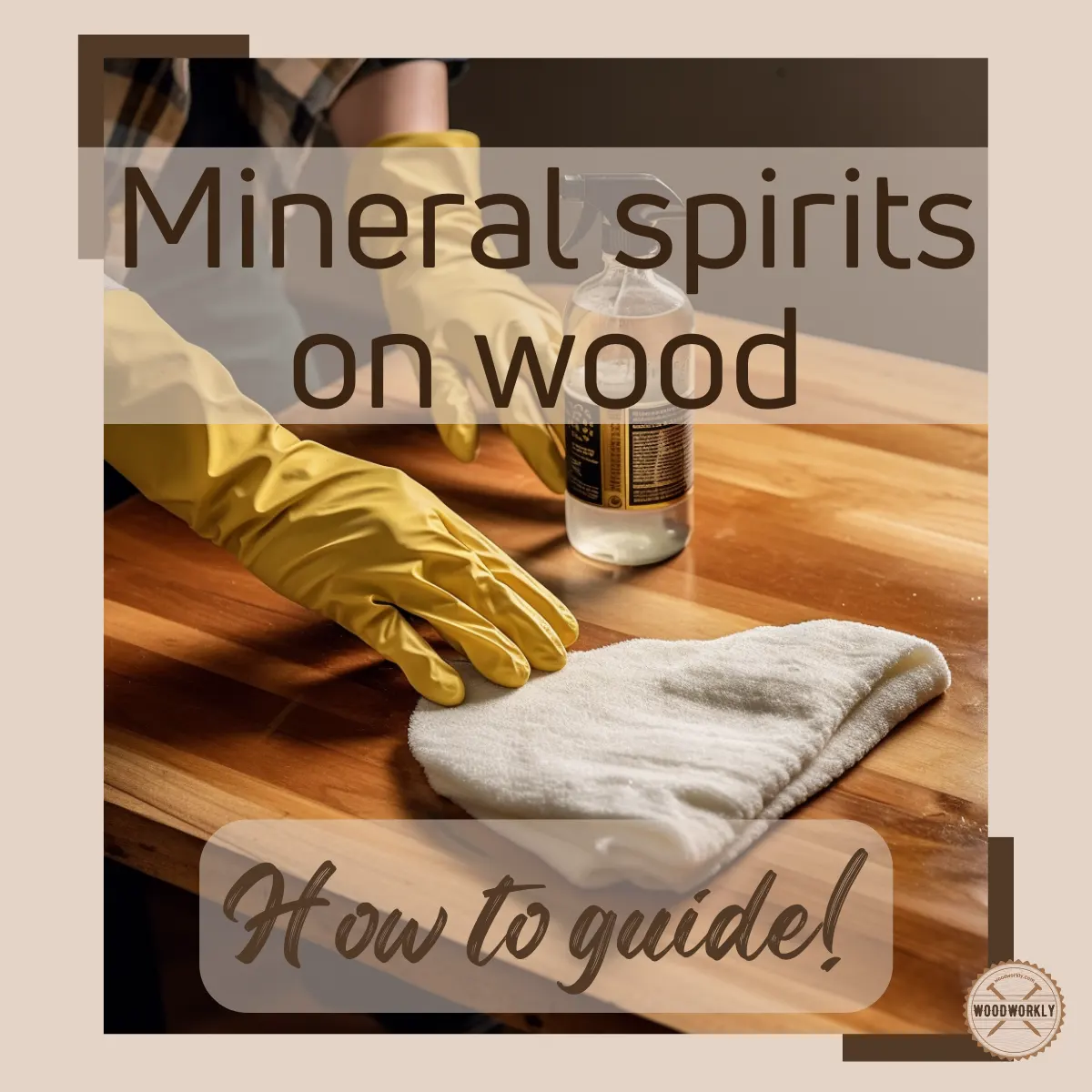
Mineral spirits are one of the most essential liquids in the woodworking world. It is used for staining and painting wood.
Mineral spirit helps to clean the wood, change the color of the wood, thin the stain, and various purposes.

When I was first working with mineral spirits, I was curious about using mineral spirits in the proper way.
So, I did some research and gathered advice from experts to find out, How to use mineral spirits on wood?
To use mineral spirits on wood, apply sparingly with a clean cloth, rubbing gently to remove dirt, residue, or finish. For highlighting wood grain, apply and then wipe away excess. To clean paintbrushes, soak bristles in mineral spirits, then rinse and dry. Always test a small, hidden area first and work in a ventilated space.
But there’s more to know about using mineral spirits on wood than just that.
So, in this article, we’ll discuss how to use mineral spirits on wood with the most accurate method to renew dull wood finishes and clean the wood properly with other various types of its applications.
Furthermore, I’ll answer some frequently asked questions regarding the application of mineral spirits as well.
So, let’s jump in!
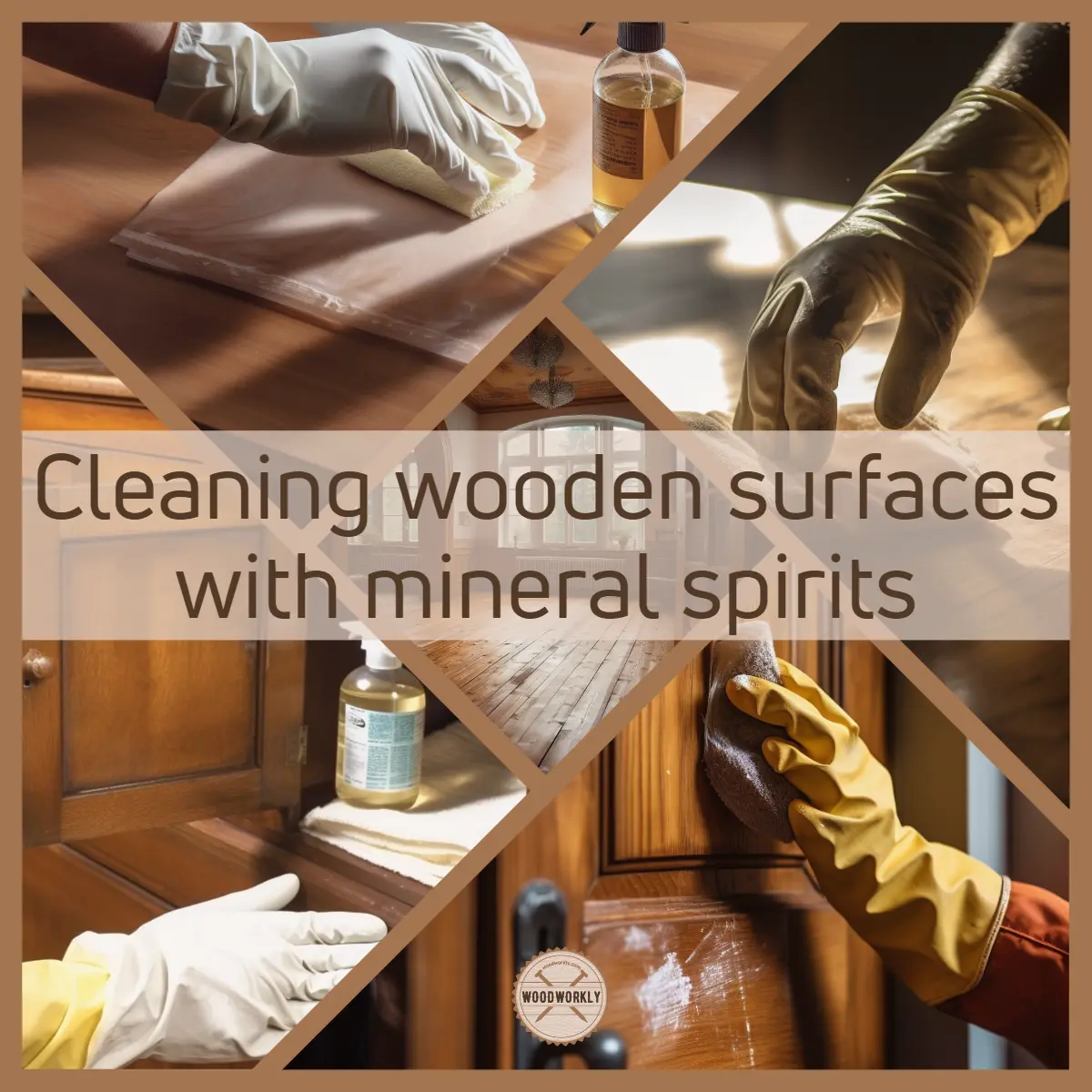
This post contains affiliate links. As an Amazon Associate, I earn from qualifying purchases. I endorse only products I truly recommend. If you make a purchase using one of these links, I may receive compensation at no extra cost to you. For more information, see my disclosure policies.
First have a look at what is mineral spirits and why it is such a useful chemical when it comes to wood.
What Are Mineral Spirits
Mineral spirits, sometimes referred to as white spirits or paint thinner, is a multipurpose solvent that is frequently used in the woodworking and painting industries.
Mineral spirits are petroleum-based solvents made from refined petroleum products.
They primarily serve to thin oil-based paints and varnishes to make them simpler to use and remove from surfaces.
Additionally, they function as a potent degreaser, clearing away oils, dirt, and adhesive buildup from a variety of surfaces.
They are frequently used in the woodworking sector to clean equipment, prepare surfaces, and even as a blending agent for wood stains.
Comparison to Other Solvents and Thinners
Although other solvents like turpentine are frequently compared to mineral spirits, there are several significant differences.
Turpentine has a stronger scent and might be more abrasive on some surfaces because it is made from pine tree resin.
Mineral spirits, on the other hand, have a gentler smell and are typically thought to be safer to use.
The contrast of denatured alcohol and mineral spirits is another frequent one.
Denatured alcohol, which contains ethanol as well as other chemicals, works well as a solvent for shellac and other alcohol-based treatments.
Mineral spirits, on the other hand, work well for diluting oil-based paints and varnishes.
As you can see there is a clear difference between mineral spirits and other popular solvents.
This makes mineral spirits unique and essential for projects.
The Role of Mineral Spirits in Woodworking and Painting Industries
Mineral spirits are essential to the painting and woodworking industries.
They are frequently employed by woodworkers to clean their tools and brushes, get rid of extra wood glue or finish, and prepare surfaces for painting or staining.
Additionally, certain wood treatments and stains employ them as a solvent to make them simpler to apply and blend.
Mineral spirits are a crucial product in the painting business for diluting oil-based paints and varnishes, which makes them easier to apply and produces a smoother surface.
In order to keep your instruments in good shape, they are also used for cleaning brushes, rollers, and other equipment.
Mineral spirits are a crucial tool for both painters and woodworkers.
They are a preferred option for thinning, cleaning, and degreasing because of their adaptability and effectiveness.
They can be used safely to produce amazing outcomes in your projects when handled with the right precautions and disposed of properly.
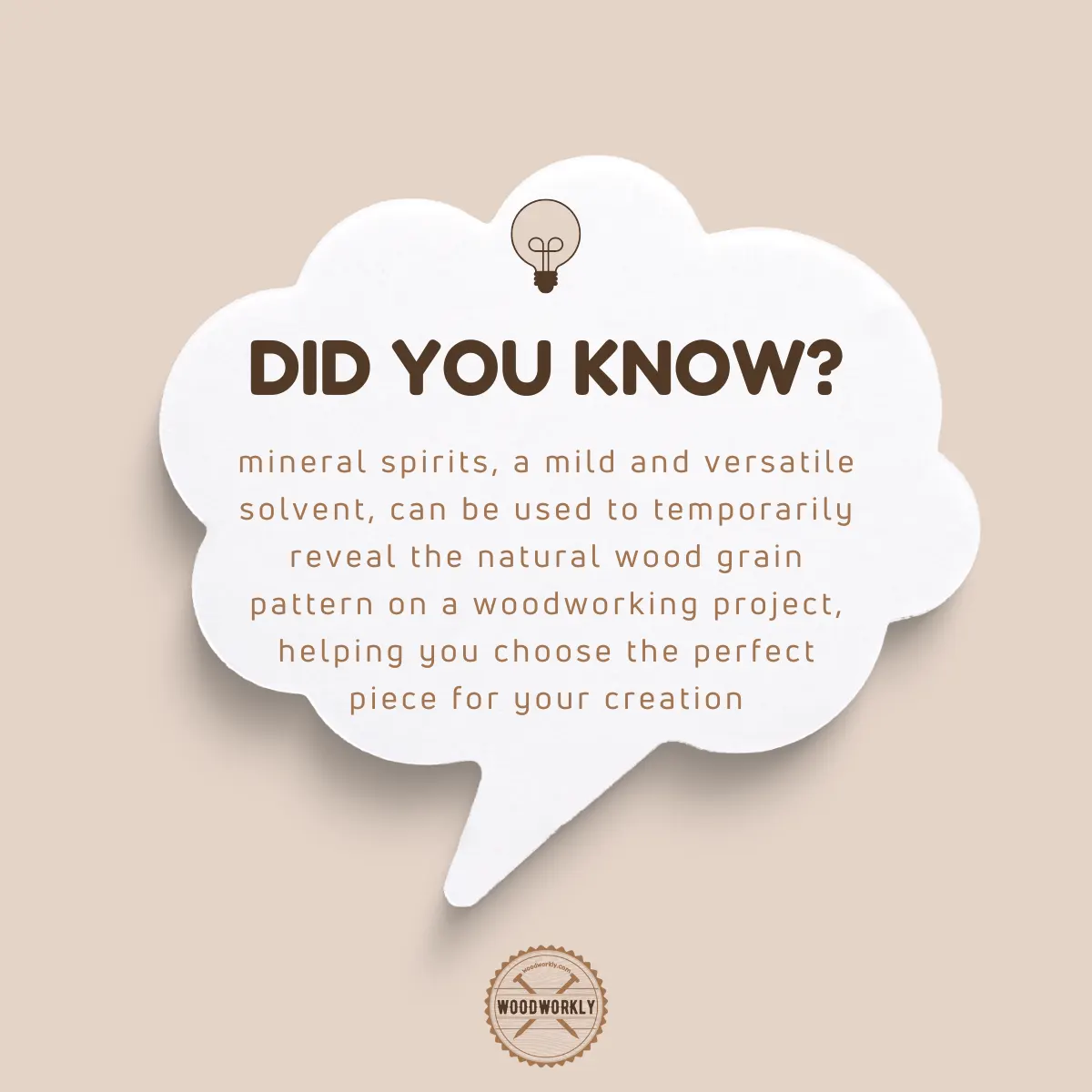
What Do Mineral Spirits Do to Wood?
Mineral spirit is an effective solvent that uses to clean the wood in different woodworking and wood-finishing projects.
Basically, mineral spirits bring the original luster of the wood by cleaning off the grime that build-up through the years.
When you apply mineral spirits to wood, it works as a solvent that dissolves wood stain, paint, and many other oil-based products.
When mineral spirits interact with molecular particles of those finishes, they’ll loosen their bond with wood, and they cut through the finishing lines.
Then, you’ll be able to remove them easily and clean the wood without getting a dull look.
Ultimately mineral spirits are capable of giving a fresh look to any kind of wood by eliminating dirt and residue.
Here’re the uses of mineral spirits,
- Clean the wood surface by dissolving it with the existing wood finish and make remove it from the surface.
- Mineral spirits clean the wood before staining and make the surface ready to accept the stain
- Mineral spirits temporarily change the color of the wood to highlight flaws and finishing lines
- Stain dark wood lighter
- Thin wood stain
- Renew dull wood finishes
- Clean Paintbrushes
- Remove tackiness from stained wood
- Clean oils from oily woods
Now you know why mineral spirits are popular in woodworking this much. It has some awesome properties that give surprising results for any type of woodwork or furniture.
So, let’s find out how to play with mineral spirits to get the best out of it.
Please note that here we are going to discuss the general application procedure of mineral spirits on wood.
After discussing the general procedure in detail, we’ll look at each and every occasion that uses mineral spirits and how to apply them properly to get the best results.
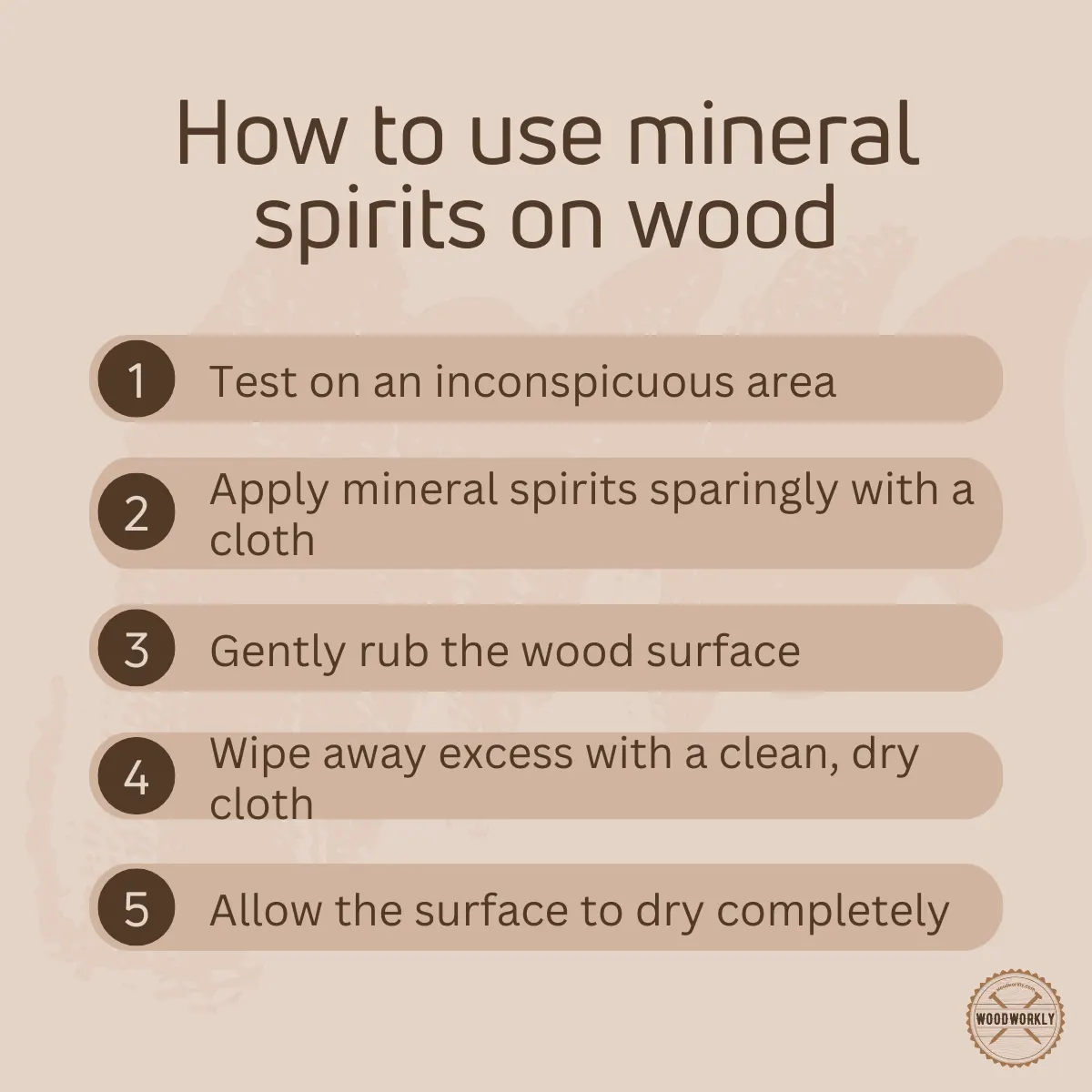
Supplies You Will Need To Use Mineral Spirits On Wood
- Mineral spirits product
- Soft, dry lint-free cloth
- 200 grit sandpaper
- Scrap wood
- Latex gloves
- Clean rags
- Tack cloths
- A toothbrush or small brush
Tip:
When you’re buying mineral spirits from a hardware store, avoid products that are marked as green or eco-friendly because they aren’t pure mineral spirits and may ruin your project due to quality issues.
How To Use Mineral Spirits on Wood? (General Method)
We use mineral spirits on wood for various tasks such as restoration projects, preparing wood before staining, cleaning projects, showing wood grain, cleaning oils from oily woods, and many more.
Whatever the project we’re willing to use mineral spirits for, the application process is almost similar.
So, let’s find out how to use mineral spirits on wood without making any mistakes.
Here’re the steps you need to follow when using mineral spirits on wood,
- Clean the wood
- Sand the wood surface
- Dampen the lint-free soft cloth with mineral spirits
- Test mineral spirits on scrap wood
- Apply mineral spirit by wiping on wood
- Let the wood dry completely
By following the above method, you can clean the wood before staining and restoring wood projects to get a nice fresh look.
So, let’s discuss each of the above steps one by one to get an idea about how to use mineral spirits on wood.
1. Clean The Wood
Before applying mineral spirits, the wood surface needs to be cleaned and free from dust and debris to accept mineral spirits.
Otherwise, the mineral spirit can be contaminated.
Therefore, surface preparation is a must before using mineral spirits on wood.
Clean the wood by wiping down the surface with a clean rag. Make sure to cover up the entire surface without missing any spots.
Or you can use a vacuum cleaner to make the surface free from dust.
Even though you’re using mineral spirits on wood to prepare the surface before staining or for a restoration project you should clean the surface first.
After cleaning the whole wood surface you’re good to step onto the sanding step.
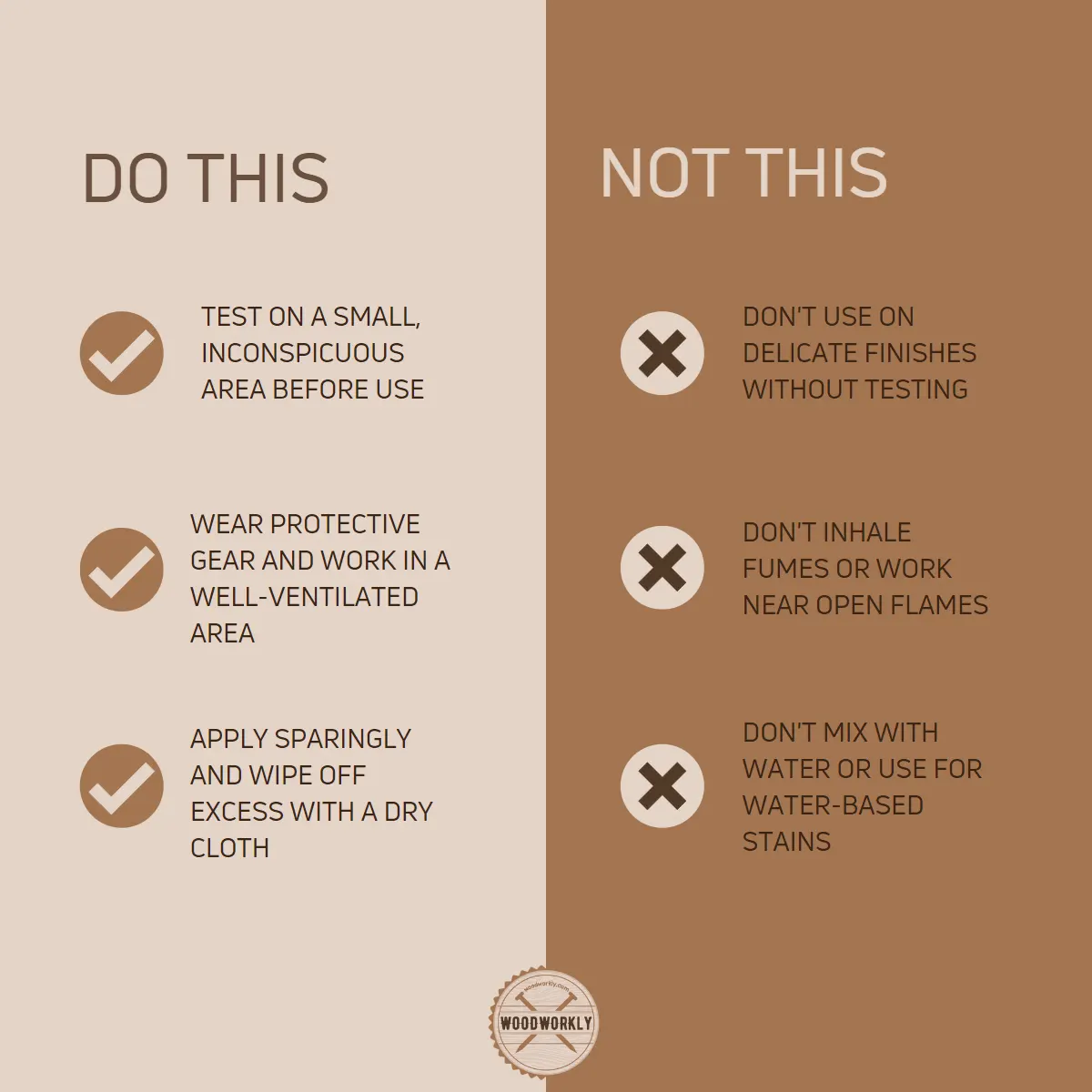
2. Sand The Wood Surface
Now sand the entire wooden surface with 220 grit sandpaper. Sanding is important to open pore structures of wood and make them available to accept mineral spirits. Sanding eliminates saw marks from manufacturing that cannot be seen by the naked eye.
If you’re going to use mineral spirits on wood to prepare the surface before staining or restoration purposes, make sure to sand along the direction of the wood grain without scratching the surface.
Never use higher-grade sandpaper, because it’ll kill the wood grain and ruin the appearance of the wood, and resist wood from taking stain evenly.
Sanding will make the surface super smooth and ready to accept the mineral spirits.
When you’re done with sanding, clean the sawdust with a vacuum or wipe the surface with a tack cloth to pick up and clean away the sawdust.
3. Dampen The Lint-Free Soft Cloth with Mineral Spirits
Now your wood surface is ready for the application process. Take the soft dry lint-free cloth and pour mineral spirits onto it until it gets saturated with mineral spirits.
Once the cloth is fully saturated with mineral spirits, you’re good to move on to the next most important step.
4. Test Mineral Spirits on Scrap Wood
Before applying mineral spirits directly to your main project, test it with scrap wood to see how it changes the color of the wood and what type of finish will it give at the end.
Better to use scrap wood same as the wood you used on the project to get to know what it will exactly look like on the woodwork.
Because different woods take mineral spirits differently.
Plus, if you’re using mineral spirits for a customer, this would be an opportunity to take a picture and say here’s what this is going to look like when it’s done or when it’s under-finished.
This way you minimize the mistakes and get a clear idea of how mineral spirit interacts with wood fibers.
5. Apply Mineral Spirits on Wood
If you’re happy with the results you got by testing mineral spirits with scrap wood it’s time to move on to the application process.
Take the clean lint-free soft cloth and dampen another portion of mineral spirits onto it.
Pour mineral spirits until the cloth gets saturated and wipe down or scrub the entire wooden area without missing any spots.
When you’re wiping the wood with a dampened rag, wipe along the direction of the wood grain gently for better acceptance of the wood and to avoid residue from going back onto the wooden surface with the cloth.
When you’re wiping the surface, you’ll notice dust, debris, and residue will pick up to the cloth and clean up the entire surface evenly.
Never use back-and-forth or circular motions when wiping the surface because that may ruin the wood.
Plus, as soon as when the cloth gets dirty, change it with a new one by saturating it with another portion of mineral spirits to make the process efficient.
Add additional amounts of mineral spirits and saturate lint-free soft cloths as much as needed to make the surface nice and clean.
In some cases, if the grime has built up for years, it’s so hard to remove them from the surface.
In those cases, apply a higher portion of mineral spirits onto those areas and scrub gently until they break the bonds with wood and remove them from the surface.
The dissolving power of mineral spirits is super cool.
Repeat the application procedure until wood fibers get saturated with mineral spirits.
This same application process can be followed when cleaning the surface before staining and for restoration projects to remove the dull look of woodwork and furniture.
To reach detailed and hard-to-reach areas, use an old toothbrush or small brush. Wipe and scrub until the build-ups come out.
Once you’re done applying mineral spirits, you’ll notice a significant change in wood because mineral spirits temporarily change the color of the wood. this is important to identify flaws and finishing lines.
6. Let the Wood Dry Completely
After using mineral spirits on wood, let the wood dry completely. the wooden surface needs to be dry properly to accept a stain or any kind of finish you want.
The average drying time of mineral spirits is about 20 minutes. Wait no longer than 20 minutes to finish the surface because mineral spirits dry quite fast.
Read the latest article about do mineral spirits evaporate to know more details about their drying times.
Drying is important to achieve the outcome of mineral spirits. You’ll notice mineral spirits enhance the grain of the wood and give a refresh to your woodwork or furniture by removing its dullness.
When the wood dries mineral spirits bring the original luster of the wood by cleaning off the grime that build up through the years.
That’s it, folks! Now you know everything about how to use mineral spirits on wood without making any mistakes.
This is the most simple and accurate method you can follow even though you’re a beginner in woodworking.
Congrats! Now you know the general procedure of applying mineral spirits on any wood. But what if your project is specific? Don’t worry! I get you covered.
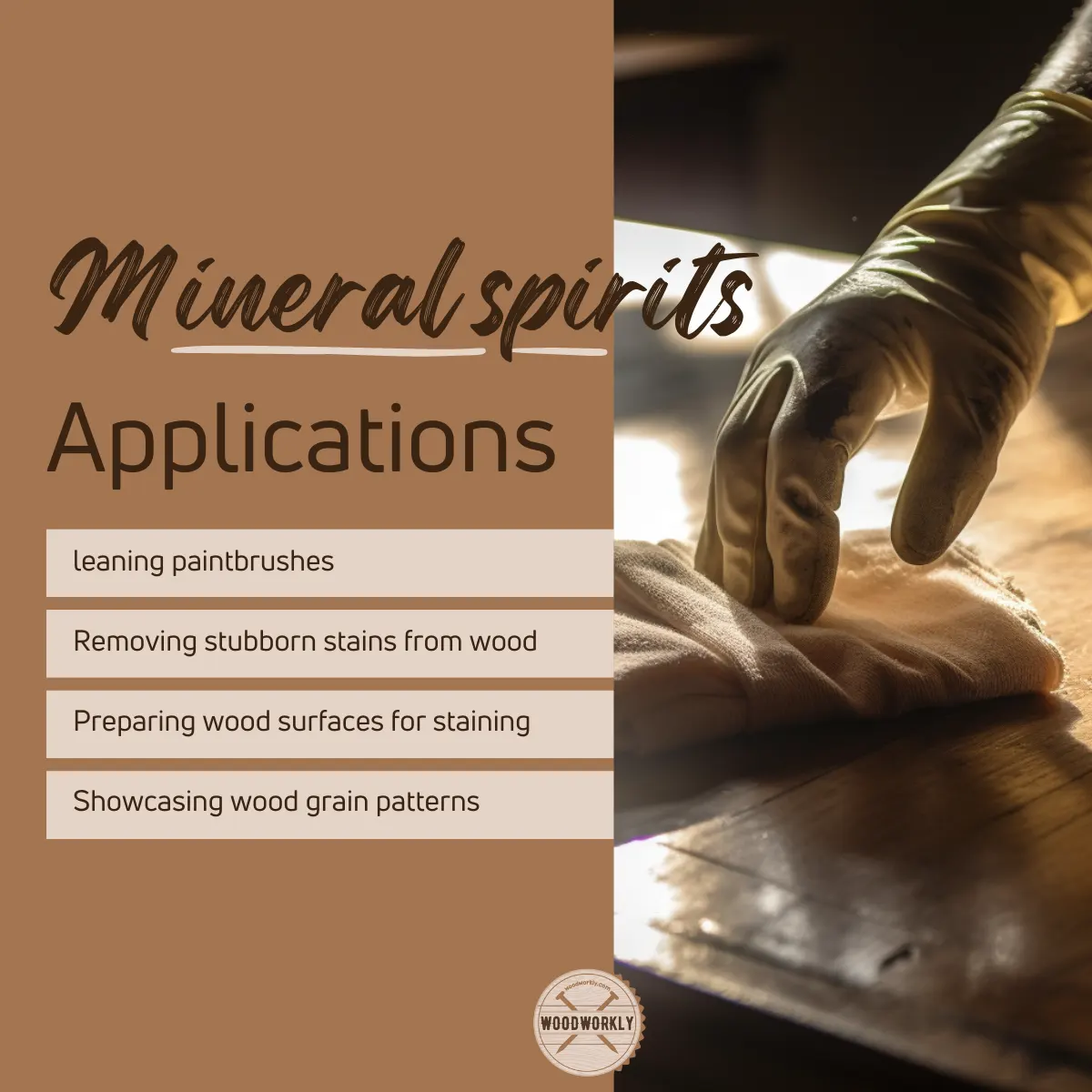
So, let’s head into special occasions where we use mineral spirits to fix the issues.
How To Use Mineral Spirits To Restore Warmth and Shine to Wood
One fantastic way to use mineral spirits in woodworking is to restore the warmth and shine of older wood pieces.
The mild nature of mineral spirits as a solvent makes it an excellent choice for this purpose, as it can effectively clean and revive the wood’s appearance without causing any damage.
Here’re the steps you need to follow when restoring the warmth and shine of wood,
- Prepare the surface: Begin by giving the wood surface a thorough cleaning to remove any dirt, dust, or debris. This ensures that the mineral spirits can work effectively on the wood itself without any hindrances.
- Dampen a soft cloth: Saturate a clean, lint-free cloth with mineral spirits. Be sure not to oversaturate the cloth, as it can cause the mineral spirits to pool on the wood’s surface, which can lead to an uneven finish.
- Apply the mineral spirits: Gently rub the dampened cloth over the wood’s surface, following the grain direction. As you work, you’ll notice that the mineral spirits lift away grime, old finishes, and built-up residue, revealing the wood’s natural beauty beneath.
- Wipe away excess: After allowing the mineral spirits to sit on the wood for a few minutes, use a clean, dry cloth to wipe away any excess solvent. This step ensures that the wood isn’t left with a wet or sticky residue.
- Buff the surface: Using a clean, dry cloth or a buffing pad, buff the wood surface to bring out its natural shine. You’ll be amazed at the transformation as the wood’s luster is restored.
How Mineral Spirits Revive the Shine of Old Wood Pieces
Mineral spirits work their magic by gently dissolving the built-up grime, old finishes, and other residues that can dull the wood’s appearance over time.
As a mild solvent, they effectively clean the wood without causing damage or stripping away its natural oils.
This process uncovers the wood’s inherent warmth and shine, giving it a refreshed and revitalized appearance.
The Mild Nature of Mineral Spirits as a Solvent
The effectiveness of mineral spirits in restoring wood’s warmth and shine can be attributed to their mild nature as a solvent.
Unlike harsher solvents, mineral spirits won’t strip the wood of its natural oils or cause damage to the surface.
This makes them an ideal choice for gently reviving the appearance of wood pieces without the risk of ruining their integrity.
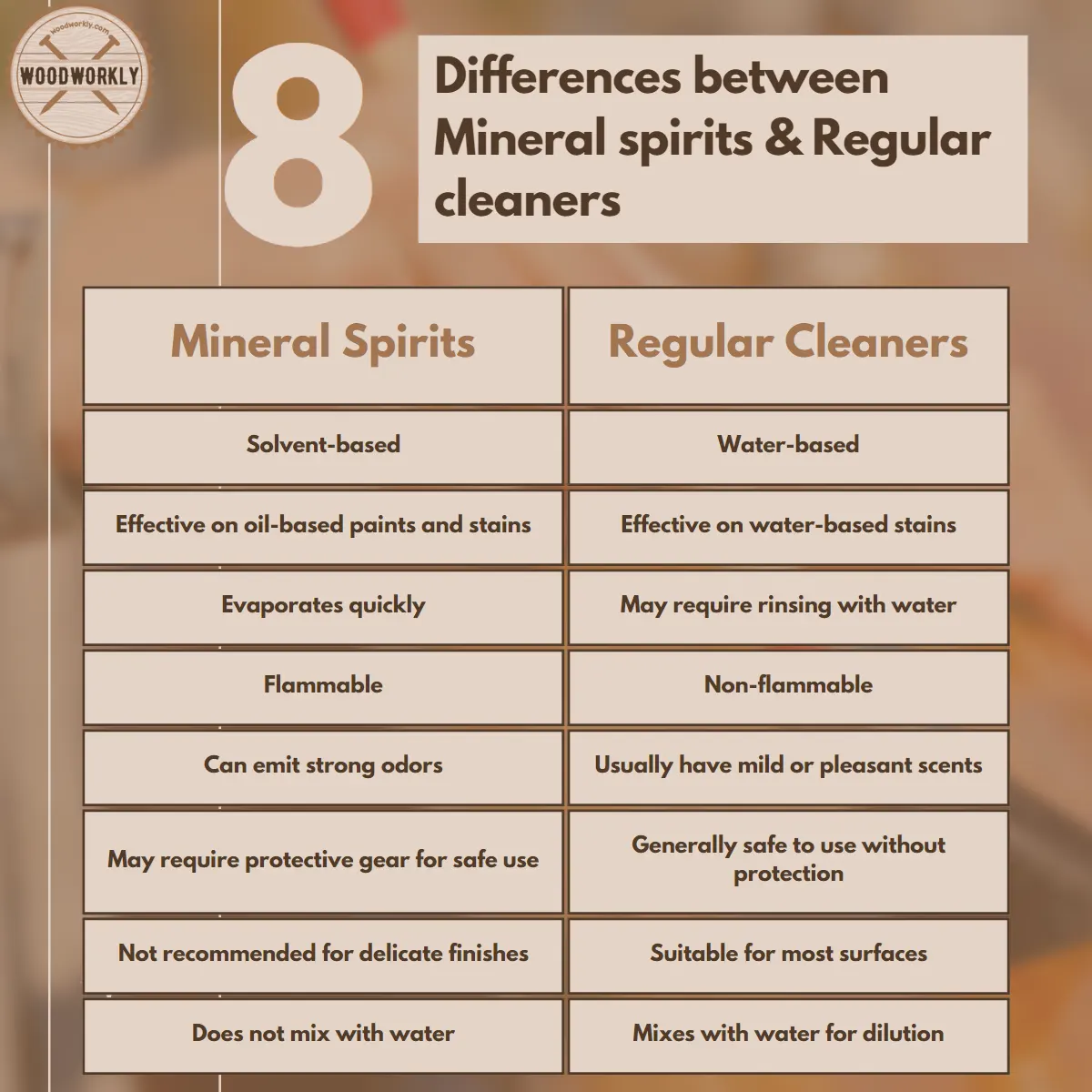
How To Use Mineral Spirits To Clean Stubborn Stains from Wood
Wood surfaces can sometimes become stained by substances like tree sap, adhesive residue, or oil-based products.
Fortunately, mineral spirits can help you tackle these stubborn stains with ease.
Mineral spirits possess the unique ability to break down and dissolve stubborn substances that might otherwise be difficult to remove from wood surfaces.
Here’s how to use mineral spirits to tackle some of the most common stains:
- Tree sap: Saturate a clean cloth with mineral spirits and gently rub the affected area until the sap dissolves. Then, wipe the surface with a clean, dry cloth to remove any remaining residue.
- Adhesive residue: Apply a small amount of mineral spirits to a cloth and rub it onto the adhesive residue. The mineral spirits will soften the adhesive, making it easier to scrape away with a plastic scraper or your fingernail. Once the adhesive is removed, wipe the area with a clean cloth.
- Oil-based stains: Dampen a cloth with mineral spirits and gently rub the stain, working in the direction of the wood grain. The mineral spirits will break down the oil, allowing you to lift it away from the wood. Wipe the surface with a clean, dry cloth to remove any remaining residue.
The Application Process for Cleaning Stains Using Mineral Spirits
When using mineral spirits to clean stubborn stains from wood, it’s essential to follow a proper application process to ensure the best results.
Here’s a step-by-step guide:
- Prepare the wood surface: Start by cleaning the wood to remove any dust, dirt, or debris that might interfere with the effectiveness of the mineral spirits.
- Test on a hidden area: Before applying mineral spirits to the stain, test them on an inconspicuous spot to ensure they won’t damage the wood or cause discoloration.
- Apply the mineral spirits: Using a clean cloth, apply the mineral spirits directly to the stain, following the instructions outlined above for the specific type of stain you’re addressing.
- Wipe away residue: Once the stain has been dissolved or loosened, use a clean, dry cloth to wipe away any remaining residue or excess mineral spirits.
- Inspect and repeat if necessary: Examine the area to determine if the stain has been fully removed. If some staining remains, repeat the process until the stain is gone.
How To Use Mineral Spirits To Prepare Wood for Staining
For the greatest results when staining wood, making sure the surface is spotless and clean is crucial.
By aiding in the removal of dust and residue left over from sanding, mineral spirits can be crucial in preparing wood for staining.
Fine dust particles produced during the sanding of wood have a tendency to collect within the wood grain, making it challenging for the stain to penetrate uniformly.
After sanding, you can clean the wood with mineral spirits to get rid of these grits and other debris, creating a smooth, even surface for the stain to adhere to.
Mineral spirits can also assist in highlighting any flaws in the wood so you can fix them before staining it.
For a staining process to be successful, the wood surface must be well cleaned and prepped.
You may make sure that your wood surface is clear of dust, debris, and other impurities that could damage the final appearance of your stained wood by using mineral spirits.
In the end, this will produce a finish that is more uniform and polished.
Application Process of Mineral Spirits To Prepare Wood For Staining
To prepare your wood for mineral spirits staining, follow these steps:
- Sand the wood: Start by sanding the wood’s surface, working your way up to a finer grit as you go. This will make the surface smooth and even and assist in removing any rough areas before staining.
- Dust removal: After sanding, most of the dust should be removed from the wood surface using a vacuum or a tack cloth.
- Apply mineral spirits: Apply mineral spirits by wetting a clean, lint-free cloth with the cleaner and gently wiping the wood surface while moving in the grain’s direction. This will assist in clearing the wood of any last-minute dust and debris.
- Examine the surface: Check the wood’s surface for any lingering flaws, such as scratches or rough areas, while the mineral spirits evaporate. Reapply mineral spirits and resand the area as necessary.
- Dry the wood: After you’re satisfied with how clean the wood is, let it air dry fully before staining it. This will make it more likely that the stain will penetrate the board uniformly and leave a uniform finish.
To achieve a smooth, even surface that will highlight the beauty of the wood grain and produce a magnificent, professional-looking finish, prepare the wood for staining using mineral spirits.
For the finest outcomes, keep in mind to operate in a well-ventilated location and to carefully follow the application method.
Check out Does Mineral Spirits Go Bad? 5 Signs to Watch Out For!
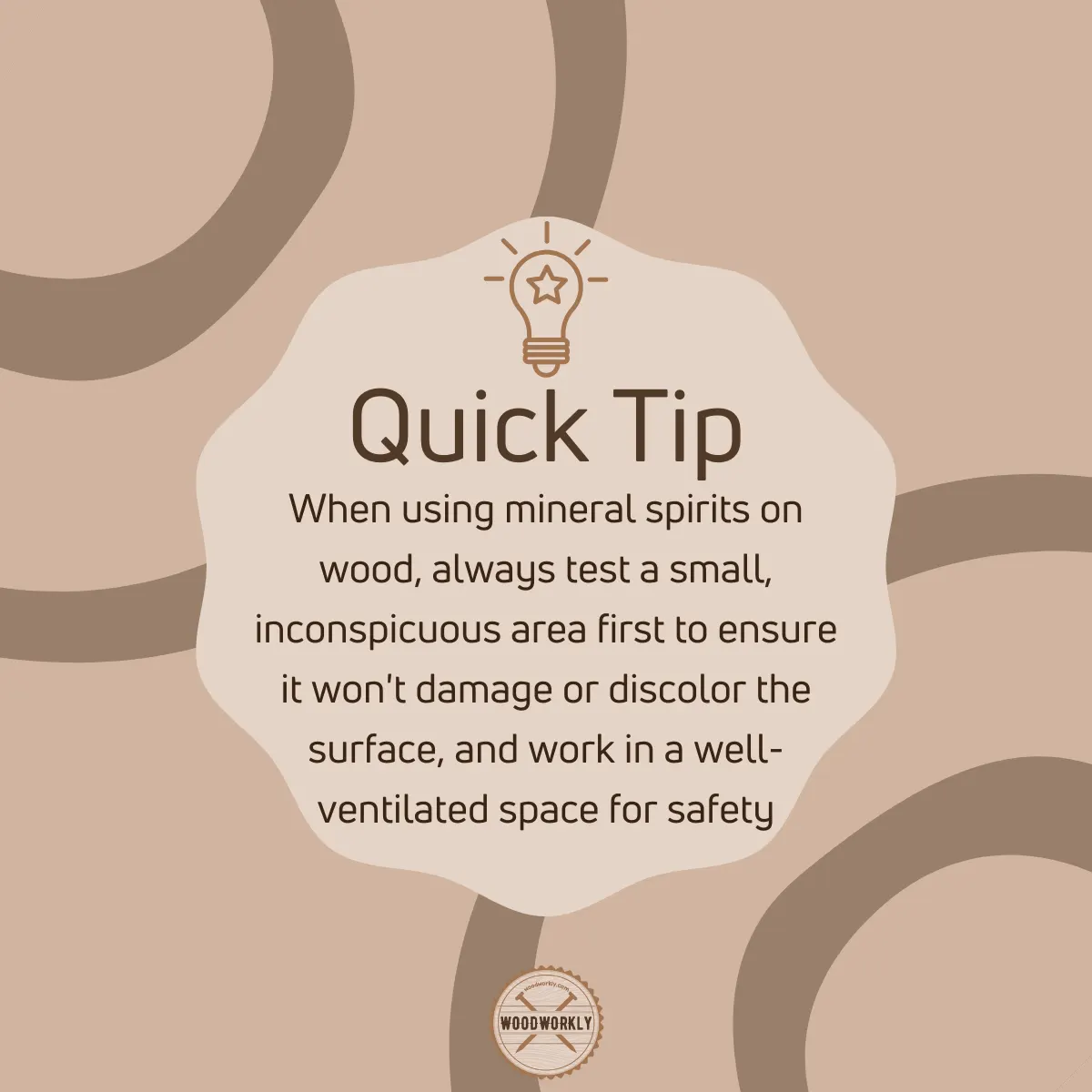
How To Use Mineral Spirits To Reveal Wood Grain
Any woodworking project benefits from the lovely and distinctive qualities of wood grain, which give it personality and depth.
You can enhance the natural beauty of the wood and choose the best piece for your project by temporarily highlighting wood grain patterns with mineral spirits.
Mineral spirits have a special power that makes the wood grain patterns temporarily more visible.
They can highlight the small variations in colour and texture that distinguish the wood’s grain when applied to the surface of the wood.
When selecting the best wood for a project or arranging the layout of a piece, this can be extremely useful.
Simply dampen a clean, lint-free cloth with mineral spirits for this purpose, then gently wipe the wood surface in the direction of the grain.
You will be able to see the wood grain patterns more clearly when the mineral spirits evaporate, which will help you appreciate the wood’s inherent beauty.
Keep in mind that once the mineral spirits have completely evaporated, the wood grain will resume its previous appearance.
How to Apply Mineral Spirits for Showcasing Wood Grain
To use mineral spirits to highlight wood grain, follow these steps:
- Clean the wood surface: Ensure the wood is free of dust, dirt, and debris by wiping it down with a dry, lint-free cloth.
- Apply mineral spirits: Dampen a clean, lint-free cloth with mineral spirits and gently wipe the wood surface, working in the direction of the grain. This will help accentuate the wood grain pattern temporarily.
- Assess the wood grain: As the mineral spirits evaporate, examine the wood grain pattern and make any necessary adjustments to your project design or wood selection based on the enhanced appearance.
- Proceed with your project: Once you’ve made any necessary adjustments, continue with your woodworking project as planned, keeping the wood grain pattern in mind as you make cuts and join pieces together.
How To Use Mineral Spirits To Clean Oils From Oily Woods
When working with exotic or oily woods, such as purpleheart or rosewoods, it can be challenging to manage the natural oils present in the wood.
These oils can interfere with the carving process, make it difficult to glue pieces together, or affect the absorption of finishes.
Luckily, mineral spirits can help remove surface oils from these woods, making the woodworking process more manageable.
Mineral spirits are an effective solvent for breaking down and removing natural oils present on the surface of oily woods.
By removing these oils, you can achieve a cleaner surface that’s easier to work with, allowing for better adhesion of glues and finishes, and making the carving process more manageable.
Application Technique for Cleaning Oils from Oily Woods
To use mineral spirits to remove surface oils from oily woods, follow these steps:
- Prepare your workspace: Ensure you have proper ventilation and wear appropriate safety gear, such as gloves and safety glasses.
- Clean the wood surface: Wipe the wood surface with a dry, lint-free cloth to remove any dust or debris.
- Apply mineral spirits: Dampen a clean, lint-free cloth with mineral spirits and gently wipe the wood surface, working in the direction of the grain. The mineral spirits will help break down and lift the surface oils from the wood.
- Wipe off excess: After allowing the mineral spirits to sit on the surface for a few moments, use a clean, dry cloth to wipe away any excess spirits and dissolved oils.
- Allow the wood to dry: Give the wood ample time to dry before continuing with your woodworking project. This ensures the mineral spirits have fully evaporated, and the surface is free of residual oils.
By using mineral spirits to clean oils from oily woods, you can create a better working surface for carving, gluing, and finishing your woodworking projects, resulting in a more enjoyable experience and a higher-quality finished product.
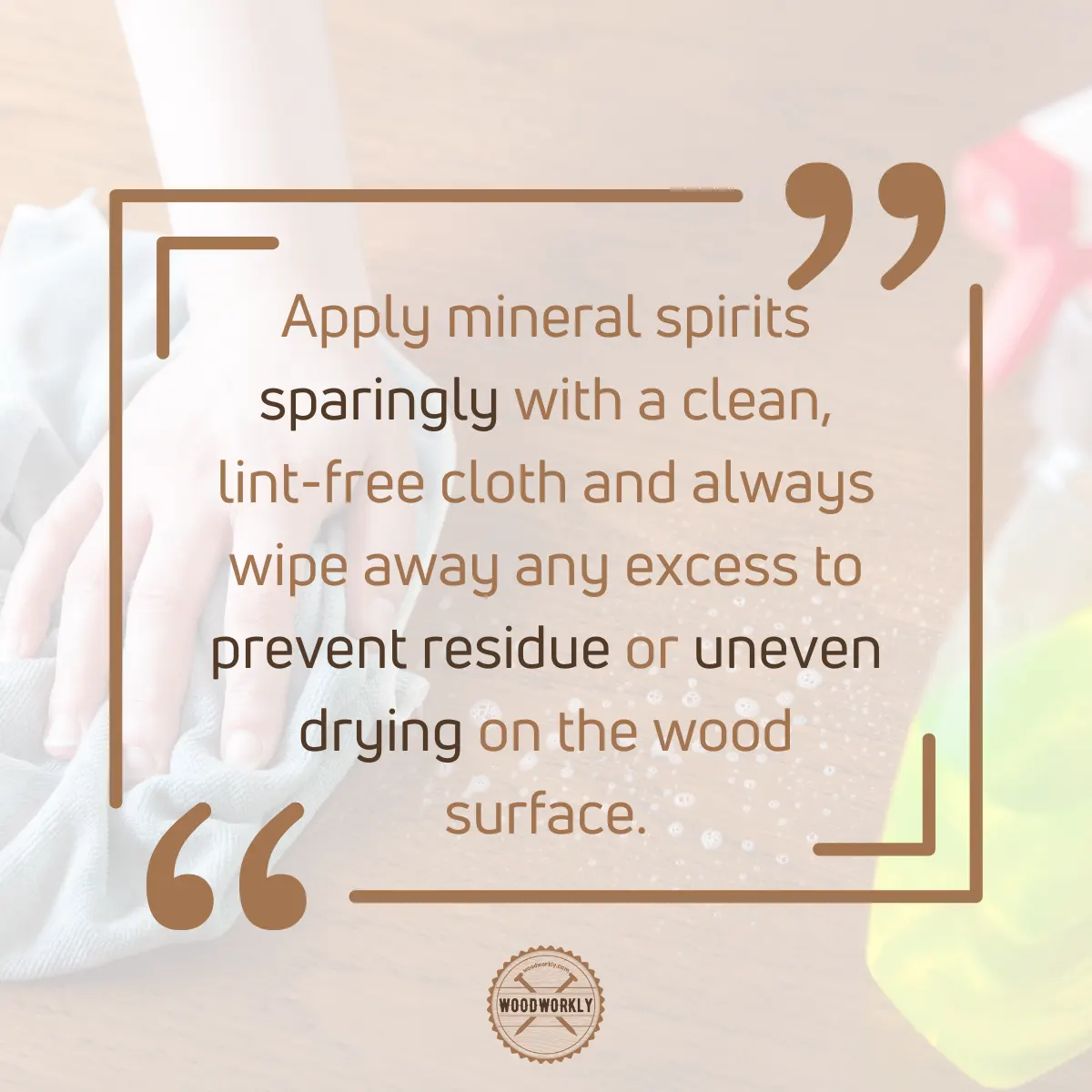
How To Use Mineral Spirits To Clean Paintbrushes
Maintaining your instruments and making sure they survive for many years requires regular brush cleaning.
Mineral spirits are an efficient and mild cleaning solution that won’t harm brush bristles when used with oil-based paints and varnishes.
How Oil-based Paints and Varnishes Dissolve in Mineral Spirits
Oil-based paints and varnishes can be effectively dissolved by mineral spirits, a petroleum-based solvent.
The mineral spirits dissolve the chemical bonds of the paint when applied to a paintbrush with dry or wet paint, making it simple to remove the paint off the bristles.
The brushes are kept clean and maintained during this procedure so they are prepared for use in the future.
Step-by-Step Process for Cleaning Brushes with Mineral Spirits
To clean your paintbrushes with mineral spirits, follow these steps:
- Prepare your workspace: Get your work area ready. Wear the proper safety equipment, such as gloves and safety glasses, and make sure there is enough ventilation.
- Remove excess paint: To get rid of extra paint, gently rub the brush against the paint can’s edge or dab the surface with a paper towel.
- Pour mineral spirits into a container: Mineral spirits should be added to a small bottle until the brush’s bristles are completely covered.
- Swirl the brush in the mineral spirits: Brush in the mineral spirits and slowly swirl it around to let the paint dissolve. Dip the paintbrush into the container and do this. You might need to soak the brush for a few minutes with difficult paint.
- Rinse the brush: Rinse the brush by taking it out of the container and giving it a gentle push to get rid of any leftover mineral spirits. To get rid of any last traces of paint, rinse the brush in a different container filled with clean mineral spirits.
- Repeat if necessary: If additional repetition is required, continue steps 4 and 5 until the bristles are clean.
After the brushes have cleaned and dried completely, keep them away from heat sources and in a cool, dry location.
How To Use Mineral Spirits To Remove Tackiness from Stained Wood
Tackiness on stained wood surfaces can be frustrating, especially when you’re expecting a smooth, even finish.
Sometimes, wood stains can remain sticky or tacky, even after they’ve had ample time to dry.
Thankfully, mineral spirits can be an effective solution for addressing these tacky finishes and ensuring a smooth, professional-looking result.
A tacky finish on stained wood can occur for several reasons.
One common cause is the over-application of wood stain, leading to a thick layer that doesn’t dry properly.
Additionally, high humidity levels or inadequate drying times can also result in a tacky surface.
Applying Mineral Spirits to Remove Tackiness
If you find yourself dealing with a tacky wood surface, mineral spirits can help.
Follow these steps to use mineral spirits to remove tackiness:
- Ensure proper ventilation: Before starting, make sure your workspace is well-ventilated and wear appropriate safety gear, such as gloves and a mask.
- Dampen a clean, lint-free cloth: Moisten a cloth with a small amount of mineral spirits, being careful not to soak it.
- Gently rub the tacky surface: Using the dampened cloth, gently rub the tacky surface in a circular motion. The mineral spirits will help dissolve the excess stain, removing the tackiness.
- Wipe away the excess: As you work, use a separate, clean cloth to wipe away any dissolved stain and mineral spirits residue.
- Let the surface dry: Allow the wood to dry completely before assessing the results. If necessary, repeat the process until the tackiness is gone.
By using mineral spirits to remove tackiness and following these tips, you’ll be on your way to achieving a smooth, even finish on your stained wood projects.
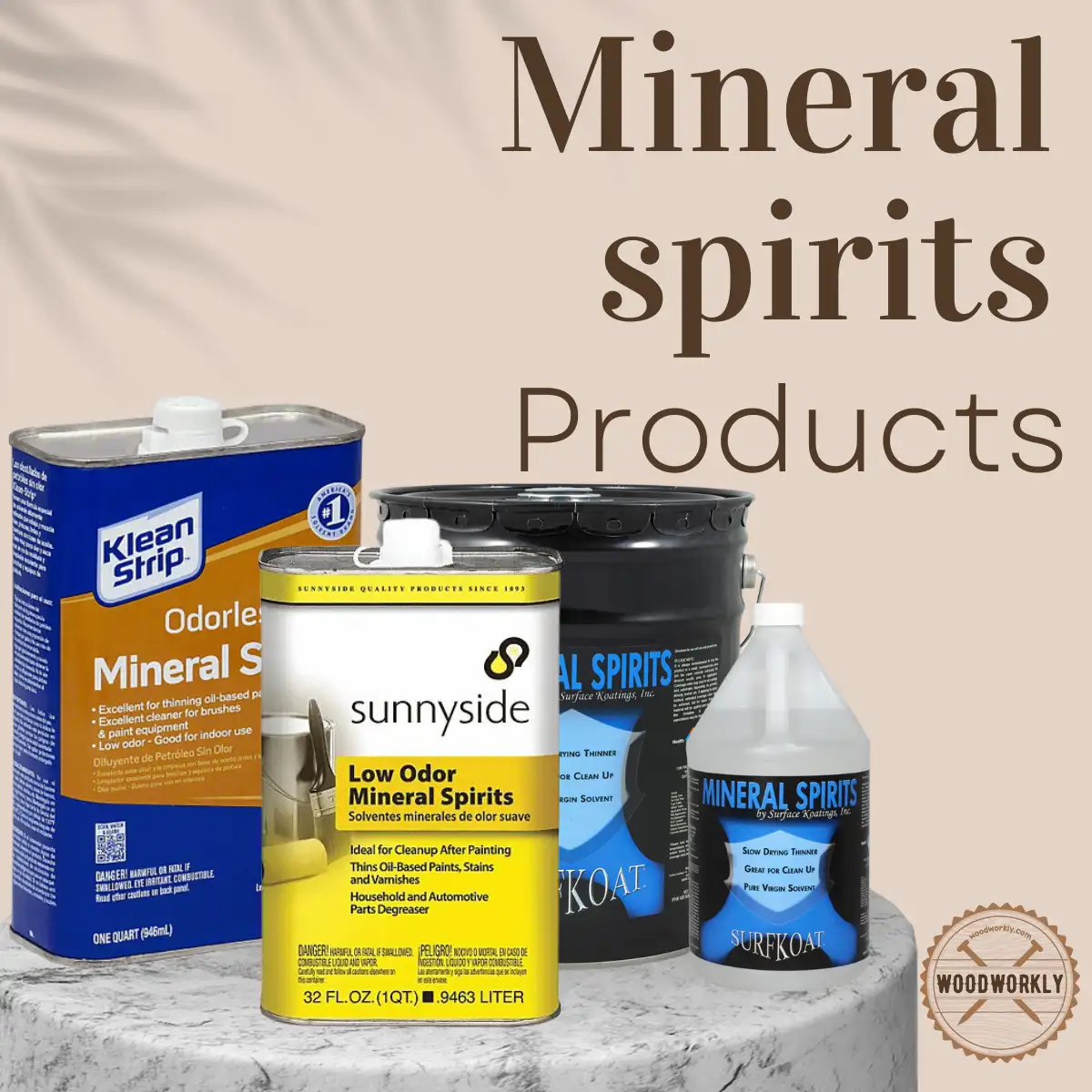
Choosing the Right Mineral Spirits for Your Project
Purchasing quality mineral spirits for your woodworking project is a must to get promising results without ruining your project.
Here are some useful things to consider before purchasing mineral spirits,
- Checking the grade of mineral spirits
- Buying mineral spirits instead of mineral oil or paint thinner
- Odorless and non-flammable options
- Importance of high-quality products
Let’s have a look at each of the above factors separately to get a good view at selecting the correct mineral spirits product for your project.
Checking the Grade of Mineral Spirits
Mineral spirits come in a variety of grades, and it’s important to select the right one for your specific needs.
These are the two most typical grades:
- Regular mineral spirits: This grade of mineral spirits is frequently used for routine cleaning and degreasing chores. It smells stronger and has more fragrant content.
- Refined or “low-odor” mineral spirits: Mineral spirits that have been refined or designated as “low-odor” have undergone additional processing to lessen their scent and odor. They are perfect for more delicate uses like indoor ones where ventilation may be restricted.
Always carefully check the label to be sure you’re choosing the appropriate grade for your project.
Buying Mineral Spirits Instead of Mineral Oil or Paint Thinner
Make sure you don’t mistake mineral spirits for paint thinner or mineral oil when you’re shopping for them.
Despite having a similar appearance, mineral oil is a lubricant with different solvent characteristics than mineral spirits.
On the other hand, paint thinner might be more aggressive and harm some finishes or surfaces.
To ensure you’re buying the right product, always check the label twice.
Odorless and Non-Flammable Options
Consider looking for odorless mineral spirits if you’re working in a small area or are sensitive to harsh odors.
These products have been refined further to remove most of the odor-causing compounds.
Additionally, some mineral spirits are made with the goal of being non-flammable, adding an extra measure of security while being used.
Remember that while these alternatives could cost more than conventional mineral spirits, they might be worthwhile for particular uses.
Importance of High-Quality Products
Purchasing premium mineral spirits is essential if you want to finish your woodworking tasks successfully.
Products of lower grade might not have the same amount of cleaning ability and might even leave residue on your wooden surfaces.
Choose well-known companies with a solid reputation for quality when you shop, and read user reviews to make sure you’re picking the right thing.
Recommended Mineral Spirits Products
To help you find the best mineral spirits for your woodworking needs, here are some top brands and options to consider that I currently use:
- Klean-Strip Odorless Mineral Spirits: This product offers reduced odor and is suitable for most woodworking applications. Users appreciate its effectiveness and low odor, but it may be less potent than regular mineral spirits.
- Sunnyside Corporation Regular Mineral Spirits: A popular choice for professionals and DIYers, Sunnyside Corporation offers a reliable, cost-effective product that works well for a variety of uses. Some users may find the odor strong, but it is generally considered effective.
- Crown Low-Odor Mineral Spirits: This product strikes a balance between odor and effectiveness, making it a good option for those who prefer a milder scent without sacrificing performance.
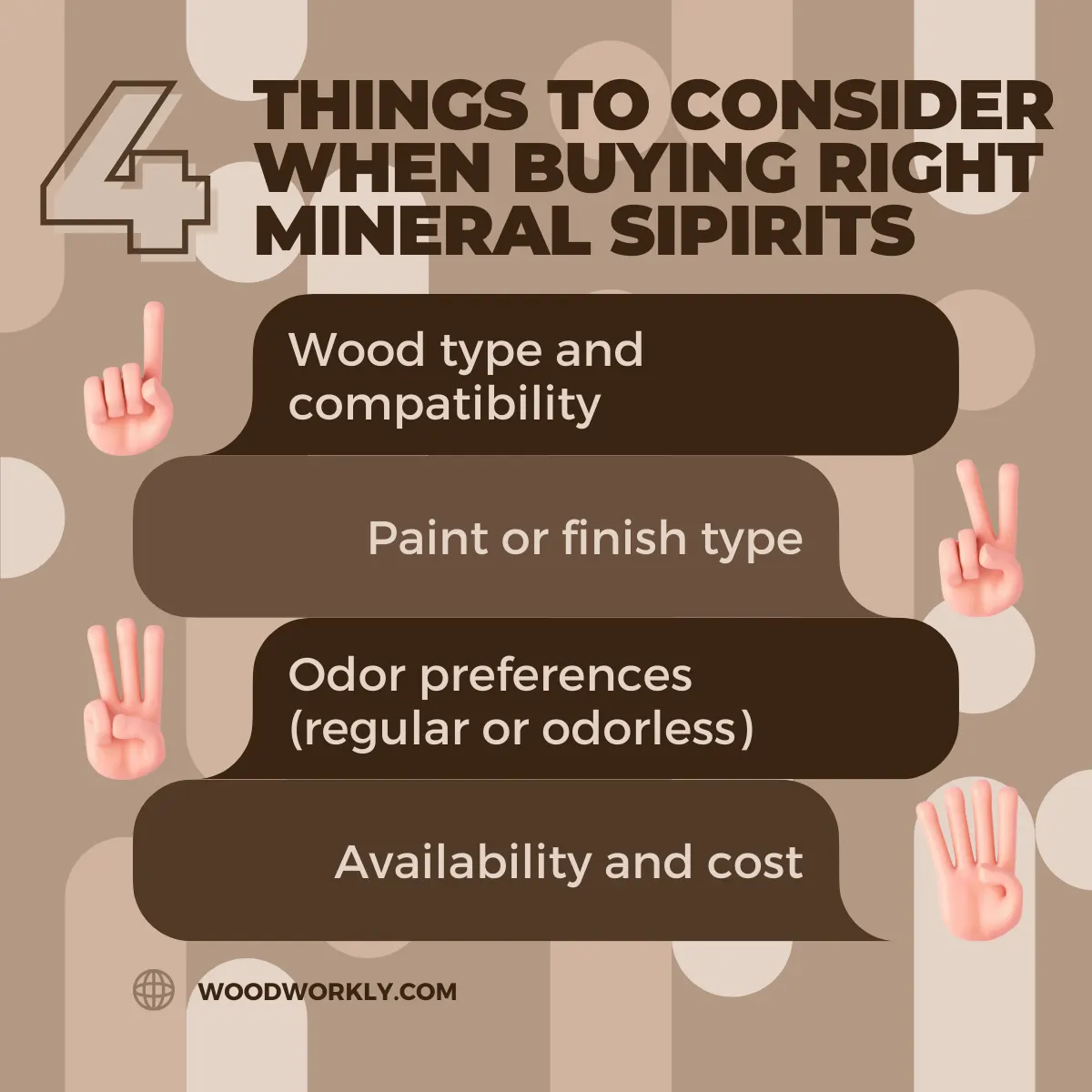
Does Mineral Spirits Darken Wood?
Mineral spirits temporarily darken the wood. But as soon as the wood gets dried it will come back to its natural color. So, mineral spirits do not discolor the wood.
When you’re applying mineral spirits on wood, the wood fibers get saturated turning their color darker and richer temporarily to highlight flaws.
Temporary Effects of Mineral Spirits on Wood
Mineral spirits are a mild solvent, which means they can temporarily darken the appearance of wood when applied.
This darkening occurs because the mineral spirits wet the wood fibers, making them appear darker and more vibrant.
However, this effect is only temporary and will dissipate as the mineral spirits evaporate.
Long-term Effects of Mineral Spirits on Wood
In the long term, mineral spirits will not cause permanent darkening or discoloration of the wood.
Once the solvent has evaporated, the wood will return to its original color.
This is why many woodworkers use mineral spirits to preview how the wood grain will appear when a finish is applied, as the temporary darkening can help highlight the grain pattern.
In the long term, mineral spirits do not affect the physical appearance of the wood. It only eliminates the dull look and cleans the surface to give a refreshing look to the wood.
How to Use Mineral Spirits Safely
While mineral spirits are an indispensable tool for many woodworking and painting projects, it’s crucial to use them safely and responsibly.
Personal Protective Equipment (PPE)
When using mineral spirits, it’s essential to wear appropriate personal protective equipment (PPE) to protect yourself from potential hazards.
Consider the following PPE:
- Gloves: Wear chemical-resistant gloves, such as nitrile or neoprene, to protect your hands from direct contact with mineral spirits.
- Eye protection: Safety goggles or glasses can help prevent eye irritation or injury from accidental splashes or contact.
- Respiratory protection: If you’re working in a poorly ventilated area or using mineral spirits in large quantities, consider wearing a respirator with an organic vapor cartridge to protect your lungs.
Ventilation and Workspace
Proper ventilation is critical when working with mineral spirits to prevent the buildup of harmful fumes.
Follow these tips to ensure a well-ventilated workspace:
- Work in a well-ventilated area: Open windows and doors or use a fan to circulate fresh air and disperse fumes.
- Avoid working near open flames or sparks: Mineral spirits are flammable, so it’s essential to avoid using them near sources of ignition like heaters, stoves, or cigarettes.
Storage and Handling
Proper storage and handling of mineral spirits are necessary to prevent accidents and ensure safety.
Keep these guidelines in mind:
- Store in a cool, dry place: Keep mineral spirits away from heat sources, direct sunlight, and open flames.
- Use a proper container: Always store mineral spirits in a tightly sealed, approved container, and never use a container that previously held food or beverages.
- Avoid prolonged skin contact: While mineral spirits are relatively mild, prolonged skin contact may cause irritation. Wash your hands thoroughly after using mineral spirits and avoid touching your face or eyes.
First Aid and Emergency Response
In case of an accident or emergency involving mineral spirits, it’s essential to know how to respond:
- Eye contact: If mineral spirits come into contact with your eyes, flush them with water for at least 15 minutes and seek medical attention.
- Skin contact: Wash the affected area with soap and water, removing any contaminated clothing. If irritation persists, consult a healthcare professional.
- Inhalation: If you experience dizziness, headache, or difficulty breathing after inhaling mineral spirits, move to fresh air and seek medical attention if symptoms persist.
- Ingestion: If mineral spirits are accidentally ingested, do not induce vomiting. Call a poison control center or seek medical assistance immediately.
By following these safety guidelines and taking the necessary precautions, you can safely use mineral spirits in your woodworking and painting projects while minimizing any potential risks.
How To Dispose of Mineral Spirits
Proper disposal of mineral spirits is essential to protect the environment and comply with local regulations.
Since mineral spirits are considered hazardous waste, it’s crucial to follow proper disposal methods.
Allow Used Mineral Spirits to Settle
After using mineral spirits, especially for cleaning paintbrushes, the liquid may contain particles of paint or other contaminants.
To separate the contaminants from the mineral spirits, follow these steps:
- Pour the used mineral spirits into a sealable container, like a glass jar or a metal can with a lid.
- Allow the container to sit undisturbed for several days. Over time, the paint particles and other contaminants will settle to the bottom.
- Once the contaminants have settled, carefully pour the clear mineral spirits into another container, leaving the sludge at the bottom.
Reuse or Recycle Clean Mineral Spirits
Clean, separated mineral spirits can be reused for future projects or recycled.
To reuse, simply pour the clear mineral spirits into a clean, sealable container for storage.
If you prefer to recycle the mineral spirits, contact a local recycling center or hazardous waste facility to inquire about their recycling programs for solvents.
Dispose of Contaminated Sludge
The sludge left behind after separating the mineral spirits contains contaminants and should be disposed of as hazardous waste.
Follow these steps:
- Leave the sludge in its original container, or transfer it to a smaller, sealable container if necessary.
- Seal the container tightly and label it as hazardous waste, specifying that it contains contaminated mineral spirits.
- Contact your local hazardous waste facility to find out about their disposal procedures and any fees that may apply. You may need to schedule a drop-off appointment or take advantage of a household hazardous waste collection event.
Follow Local Regulations and Guidelines
Keep in mind that disposal regulations for hazardous waste, including mineral spirits, may vary depending on your location.
Always check with your local authorities or waste management facility for specific guidelines and requirements to ensure that you are compliant with local regulations.
Alternatives to Mineral Spirits
The best alternatives for mineral spirits are,
- Turpentine
- Denatured alcohol
- Acetone
- Charcoal lighter fluid
- Soap and water
Let’s discuss each of the above alternative products for mineral spirits with their pros and cons.
Turpentine
Turpentine is a natural solvent derived from the resin of pine trees. It has been used for centuries as a paint thinner and wood cleaner.
Turpentine is particularly effective at dissolving oil-based paints, varnishes, and stains.
Advantages:
- Natural, renewable resource
- Effective at removing oil-based products
Disadvantages:
- Strong, unpleasant odor
- More expensive than mineral spirits
- Potentially more hazardous to health and the environment
Denatured Alcohol
Denatured alcohol, also known as methylated spirits, is a versatile solvent that can be used for cleaning wood surfaces, removing ink and other stains, and thinning shellac-based finishes.
It evaporates quickly, leaving no residue behind.
Advantages:
- Fast-evaporating, residue-free
- Effective at cleaning wood surfaces and removing stains
Disadvantages:
- Not suitable for oil-based paints and finishes
- Flammable and potentially hazardous
Acetone
Acetone is a powerful, fast-evaporating solvent that can be used to clean wood, remove adhesives, and thin some finishes.
It is particularly effective at dissolving certain types of glues and removing paint from brushes.
Advantages:
- Fast-evaporating, residue-free
- Effective at dissolving glues and cleaning brushes
Disadvantages:
- Harsh on the skin and respiratory system
- Highly flammable
- May damage some wood finishes
Water-Based Cleaners
For less aggressive cleaning tasks, water-based cleaners can be an environmentally friendly alternative to mineral spirits.
These products are less toxic, emit fewer fumes, and can be effective at removing dirt, grime, and some types of stains from wood surfaces.
Advantages:
- Environmentally friendly
- Low odor and toxicity
- Suitable for light cleaning tasks
Disadvantages:
- Less effective at removing oil-based products
- May require more elbow grease for stubborn stains
That’s it, folks! Now you know everything you wanted to know about how to use mineral spirits on wood with all the guidelines you should follow when purchasing, applying, storing, and disposing of mineral spirits for better use.
So, let’s answer some frequently asked questions as well.
Can mineral spirits be used on all types of wood?
Mineral spirits can be used on most types of wood, but it’s essential to test a small, inconspicuous area first to ensure it won’t damage or discolor the wood.
Some woods, particularly those with delicate finishes, may react adversely to mineral spirits, so always proceed with caution and follow the manufacturer’s instructions if available.
Can I use mineral spirits to clean wood furniture?
Yes, mineral spirits can be used to clean wood furniture, particularly to remove stubborn stains or residue from wood surfaces.
However, it’s essential to test a small, hidden area first to ensure it won’t damage the finish.
Use a soft cloth dampened with mineral spirits to gently rub the stained area, then wipe clean with a dry cloth.
Do mineral spirits evaporate completely, or do they leave a residue?
Mineral spirits evaporate relatively quickly, and when used correctly, they should not leave a residue on the wood surface.
To avoid any residue, apply the mineral spirits sparingly and wipe off any excess with a clean, dry cloth.
Is it necessary to wear protective gear when using mineral spirits?
When using mineral spirits, it’s essential to take appropriate safety precautions.
Wear gloves to protect your skin, and use the product in a well-ventilated area to minimize inhalation of fumes.
If you’re working in a confined space, consider wearing a respiratory mask.
Additionally, keep the mineral spirits away from open flames or sources of ignition, as the product is flammable.
Can I dilute mineral spirits with water?
No, mineral spirits and water do not mix. Mineral spirits are oil-based and will not combine with water.
If you need to dilute mineral spirits, you should use a compatible solvent, such as paint thinner or turpentine.
However, it’s essential to follow the manufacturer’s instructions and recommendations for diluting and using mineral spirits.
How long does it take for mineral spirits to dry?
The drying time for mineral spirits can vary depending on factors such as temperature, humidity, and the amount applied.
Generally, mineral spirits will evaporate and dry within 15 to 20 minutes under normal conditions.
To ensure proper drying, it’s essential to use the mineral spirits sparingly and in a well-ventilated area.
How do I clean mineral spirits off wood surfaces?
If you need to clean mineral spirits off wood surfaces, use a clean, dry cloth to gently wipe away any excess liquid.
If necessary, you can also dampen the cloth with a small amount of water to help remove any remaining residue.
After wiping the surface, allow it to air dry completely before proceeding with any further treatment or finishing.
Can I use mineral spirits on raw wood?
Yes, mineral spirits can be used on raw, unfinished wood to clean the surface, remove oils or residue, and prepare the wood for staining or finishing.
When using mineral spirits on raw wood, be sure to apply the product sparingly and test a small, hidden area first to ensure it won’t cause any damage or discoloration.
After application, wipe away any excess with a clean, dry cloth and allow the surface to dry completely before proceeding with staining or finishing.
Can You Use Mineral Spirits to Remove the Stain?
Yes, mineral spirits can weaken the bond between the stain and wood and remove the stain from the surface.
When the surface is tacky and sticky due to wood stain mistakes, use mineral spirits to remove the excess stain.
It works as a solvent that mixes with stains and helps to remove them and clean the surface.
To remove stains from any wood, pour mineral spirits onto a lint-free soft cloth and scrub the stained area.
It cleans stubborn stains from any wood.
Can Mineral Spirits Damage Wood?
Mineral spirits do not damage any wood. It is safe on wood. mineral spirits work only with finishes by softening them to lose bonds with the wood surface.
Mineral spirits only raise the grain that can be sanded off.
But if you’re working with oily wood, I have to admit that mineral spirits remove oils from the wood. This doesn’t damage the wood because that is also a part of its wood cleaning process.
Overall, mineral spirits are good to clean wood for any woodworking project.
How To Use Mineral Spirits to Remove Paint?
To remove paint, dampen a soft, clean lint-free cloth with mineral spirit and scrub the painted surface until it removes from the surface. Do this before mineral spirits dry.
Mineral spirits help to soften the paint coatings and break bonds between the paint and wood.
Therefore, paints will easily remove from the surface. You can try this method to remove oil paints from any wood.
Did I cover all you wanted to know about How to Use Mineral Spirits on Wood?
In this article, we have deeply explored how to use mineral spirits on wood using the most simple and accurate method.
I’ve explained each step separately to minimize application mistakes.
To use mineral spirits on wood, apply sparingly with a clean cloth, rub gently to clean or remove residue, and then wipe off any excess with a dry cloth. Ensure proper ventilation, wear gloves for protection, and test a small, hidden area first to avoid damaging the wood surface.
Furthermore, I have answered some hot frequently asked questions about mineral spirits on wood as well.
Hope you have learned everything about how to use mineral spirits on wood using the correct procedure.
Make sure to particle the things you have learned from this article with scrap wood before heading into the main project.
Practice makes you perfect!